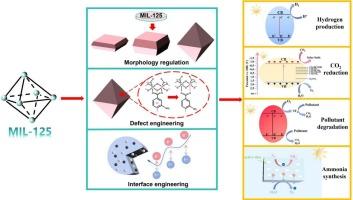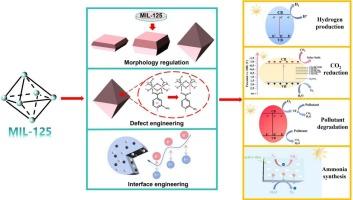mil -125基光催化纳米材料的表面与界面工程及其应用
IF 23.5
1区 化学
Q1 CHEMISTRY, INORGANIC & NUCLEAR
引用次数: 0
摘要
在日益严重的能源危机和环境挑战中,mil -125光催化剂作为金属有机骨架(mof)的重要成员,由于其大孔隙率、结构柔韧性、功能修饰和优异的光学性能,在能源和环境领域受到了极大的关注。然而,它们有限的光催化活性仍然是一个关键问题,阻碍了mil -125基材料的实际应用。因此,人们探索了各种策略来提高mil -125基光催化剂的催化性能。本文综述了旨在提高mil -125基材料光催化效率的表面和界面工程技术,包括形貌控制、缺陷工程和异质结形成。此外,对MIL-125及其复合材料在H2生成、CO2转化、污染物降解、NH3合成等能源和环境光催化方面的应用进行了总结和讨论。展望了mil -125基材料改性利用的障碍和前景,为构建高效的mil -125基光催化剂在能源和环境催化领域的应用提供了新的途径。本文章由计算机程序翻译,如有差异,请以英文原文为准。


Surface and interface engineering of MIL-125-based photocatalytic nanomaterials and their applications
Amid increasing energy crises and environmental challenges, MIL-125-based photocatalysts, as key members of metal-organic frameworks (MOFs), have garnered significant attention in the energy and environmental sectors due to their large porosity, structural flexibility, functional modifications, and exceptional optical properties. However, their limited photocatalytic activity remains a key concern, hindering the practical application of MIL-125-based materials. As a result, various strategies have been explored to improve the catalytic performance of MIL-125-based photocatalysts. This review focuses on surface and interface engineering techniques aimed at enhancing the photocatalytic efficiency of MIL-125-based materials, including morphology control, defect engineering, and heterojunction formation. Additionally, the use of MIL-125 and its composites in energy and environmental photocatalysis applications, such as H2 generation, CO2 conversion, pollutant degradation, and NH3 synthesis, is summarized and discussed. Moreover, the barriers and prospects for modifying and utilizing MIL-125-based materials have been proposed to provide new avenues for constructing highly efficient MOFs-based photocatalysts in fields of energy and environmental catalysis.
求助全文
通过发布文献求助,成功后即可免费获取论文全文。
去求助
来源期刊

Coordination Chemistry Reviews
化学-无机化学与核化学
CiteScore
34.30
自引率
5.30%
发文量
457
审稿时长
54 days
期刊介绍:
Coordination Chemistry Reviews offers rapid publication of review articles on current and significant topics in coordination chemistry, encompassing organometallic, supramolecular, theoretical, and bioinorganic chemistry. It also covers catalysis, materials chemistry, and metal-organic frameworks from a coordination chemistry perspective. Reviews summarize recent developments or discuss specific techniques, welcoming contributions from both established and emerging researchers.
The journal releases special issues on timely subjects, including those featuring contributions from specific regions or conferences. Occasional full-length book articles are also featured. Additionally, special volumes cover annual reviews of main group chemistry, transition metal group chemistry, and organometallic chemistry. These comprehensive reviews are vital resources for those engaged in coordination chemistry, further establishing Coordination Chemistry Reviews as a hub for insightful surveys in inorganic and physical inorganic chemistry.
 求助内容:
求助内容: 应助结果提醒方式:
应助结果提醒方式:


